Complete Solutions to Example of chapter SEMICONDUCTORS of Class 12 book with complete answers and questions
| Class 12 | PHYSICS |
| Chapter | SEMICONDUCTORS |
| CP SINGH | Example |
| Number Of Questions | 26 |
| Academic Year | 2023-24 |
Pure Si at 300 K has equal electron `(n_(e))` and hole `(n_(h))` concentrations of `1.5xx10^(16)m^(-3)` doping by indium increases `n_(h)` to `4.5xx10^(22)m^(-3)`. Caculate `n_(e)` in the doped Si-
01:20View SolutionDetermine the number of density of donor atoms which have to be added to an intrisic germanium semiconductor to produce an `n`-type semiconductor of conductivity `5mho//cm`. Given that the mobility of electrons in `n`-type semiconductor is `3850cm^(2)//volt-sec`.
View SolutionThe concertration of hole-electron pairs in pire silicon at `T=300K` is `7xx10^(15` per cubic metre. Antimoy is doped into silicon in a proportion of `1` arom in `10^(7)` atoms. Assuming that half of the inpurity atoms contribute electrons in the conduction band, calculate the factor electrons in the conduction band, calculate the factor by which the number of charge carriers increase due to doping. the number of silicon atoms per cubic meter is `5xx10^(28)`.
04:54View SolutionThe energy gap of pure `Si` is `1.1 eV` The mobilities of electrons and holes are respectively `0.135 m^(2) V^(-1) s^(-1)` and `0.048 m^(2) V^(-1) s^(-1)` and can be taken as independent of temperature. The intrinsic carrier concentration is given by `n_(i) = n_(0) e^(-Eg//2kT)`.
Where `n_(0)` is a constant, `E_(g)` The gap width and `k` The Boltmann's constant whose vaue is `1.38 xx 10^(-23) JK^(-1)` The ratio of the electrical conductivities of `Si` at `600 K` and `300 K` is.05:39View SolutionFind the current produced at room temperature in a pure germanium plate of area `2 xx 10^(-4) m^(2)` and of thickness `1.2 xx 10^(-3) m` when a potential of `5 V` is applied across the faces. Concentration of carries in germanium at room temperature is `1.6 xx 10^(6)` per cubic metre. The mobilities of electrons and holes are `0.4 m^(2) V^(-1) s^(-1)` and `0.2 m^(2) V^(-1) s^(-1)` respectively. The heat energy generated in the plate in `100` second is.
04:37View SolutionIf resistivity of pure silicon is `3000 Omega meter`, and the electron and hole mobilities are `0.12 m^(2)V^(-1)s^(-1)` and `0.045m^(2)V^(-1)s^(-1)` respectively, determine the resistivity of a specimen of the material when `10^(19)` atoms of phosphorous are added per `m^(3)` are also added. Given charge on electron `=1.6x10^(-19)C`.
04:32View Solution(a) Find the conductivity of intrinsic silon at `300K`. It is given that `n_(i)` at `300K` in silicon is `1.5x10^(10)//cm`^(3) and the mobilities of electrons and holes in silicion are `1300cm^(2)//V-sec` and `500 cm^(2)//V-sec` respectively.
(b) if donor type impurity is added to the extent of `1` impurity atom in `10^(8)` sillicon atoms, find the conductivity.
(c ) if acceptor inpurity is added to the extent of `1` impurity atom in `10^(8)` silicon atoms,find the conductivuity.
Given: number of `atoms//m^(3)` for `Si=5xx10^(28)`08:07View SolutionA `N`-type silicon sample of width `4xx10^(-3)m`, thickness and length `6xx10^(-2)m` carriers a current of `4.8mA`, when the voltage is applied across the length of the sample. The free electron density is `10^(22)m^(-3)`
05:18View SolutionA potential barrier of `0.3V` exists across a `p-n` junction.
(a) if the depletion region is `1mum` width. What is the intensity of elctric field in this region ?
(b) An electron with speed `5xx10^(5)m//sec` approaches this `p-n` junction from `n`-side, what will be its speed on entering the `p`-side?04:49View SolutionIn the following problems, assume that the resistance of each diode is zero in forward bias and infinity in reverse bias .
(a) Find the current supplied by the battery in the following cases. (b) Find the currents through the resistance in the circuits shown in the figures.
(c ) Find the current through the battery in each of the circuits shown in the figures.
(d) Find the equivalent resistance of the network shown in the figure between the points `A` and `B`.

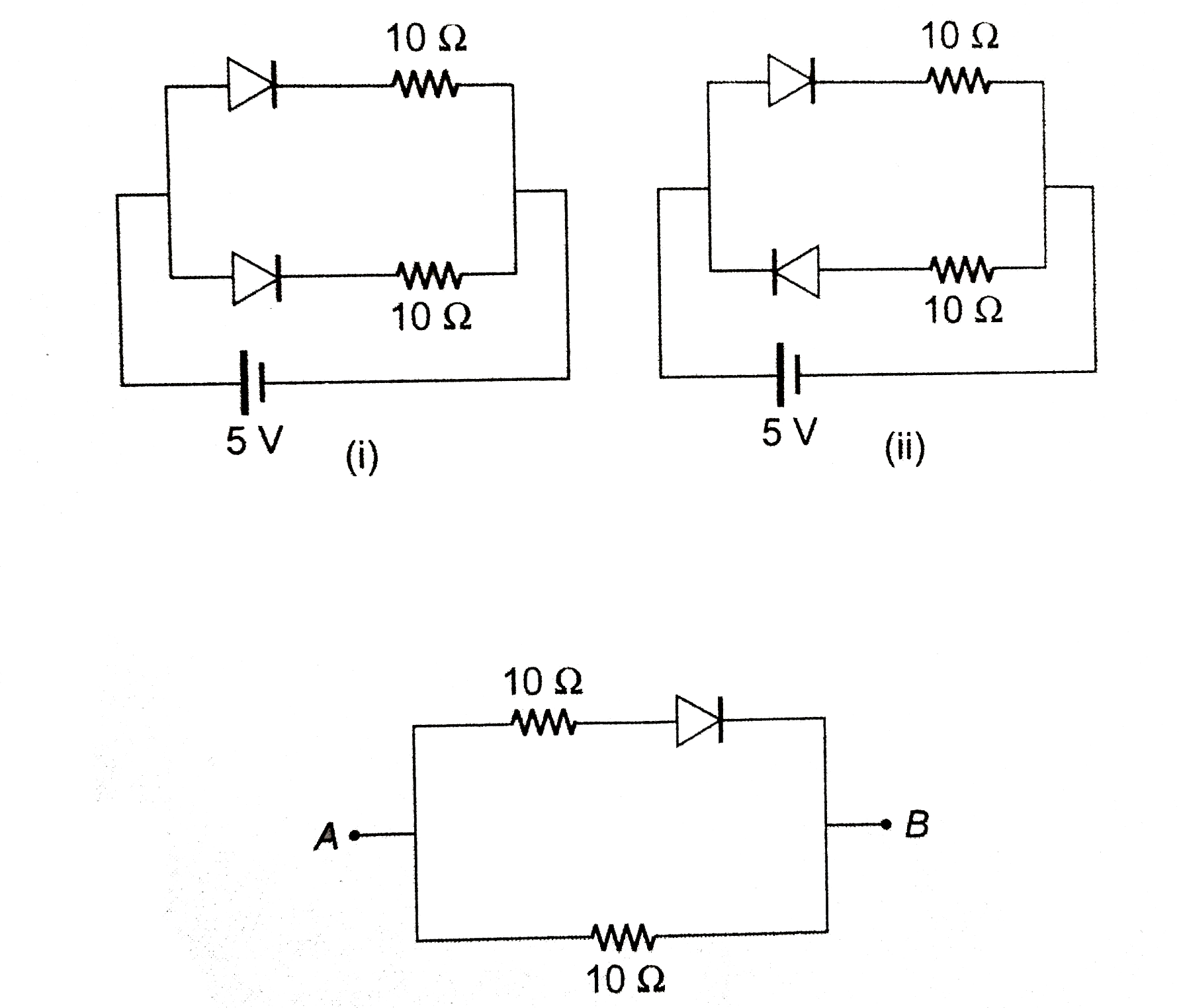 View Solution
View Solution(a) What are the readings of the ammeters `A_(1)` and `A_(2)` shown in the figure.neglect the resistance of the meters.
(b) Calculate the current through the circuit and the potential difference across the diode shown in the figure. The drift current fo the diode is `20muA`.
(c ) Each of the resistances shown in the figure has a value of `20Omega`. find the equivalent resistance between `A` and `B`. Does it depend on whether the point `A` or `B` is at higher potential?
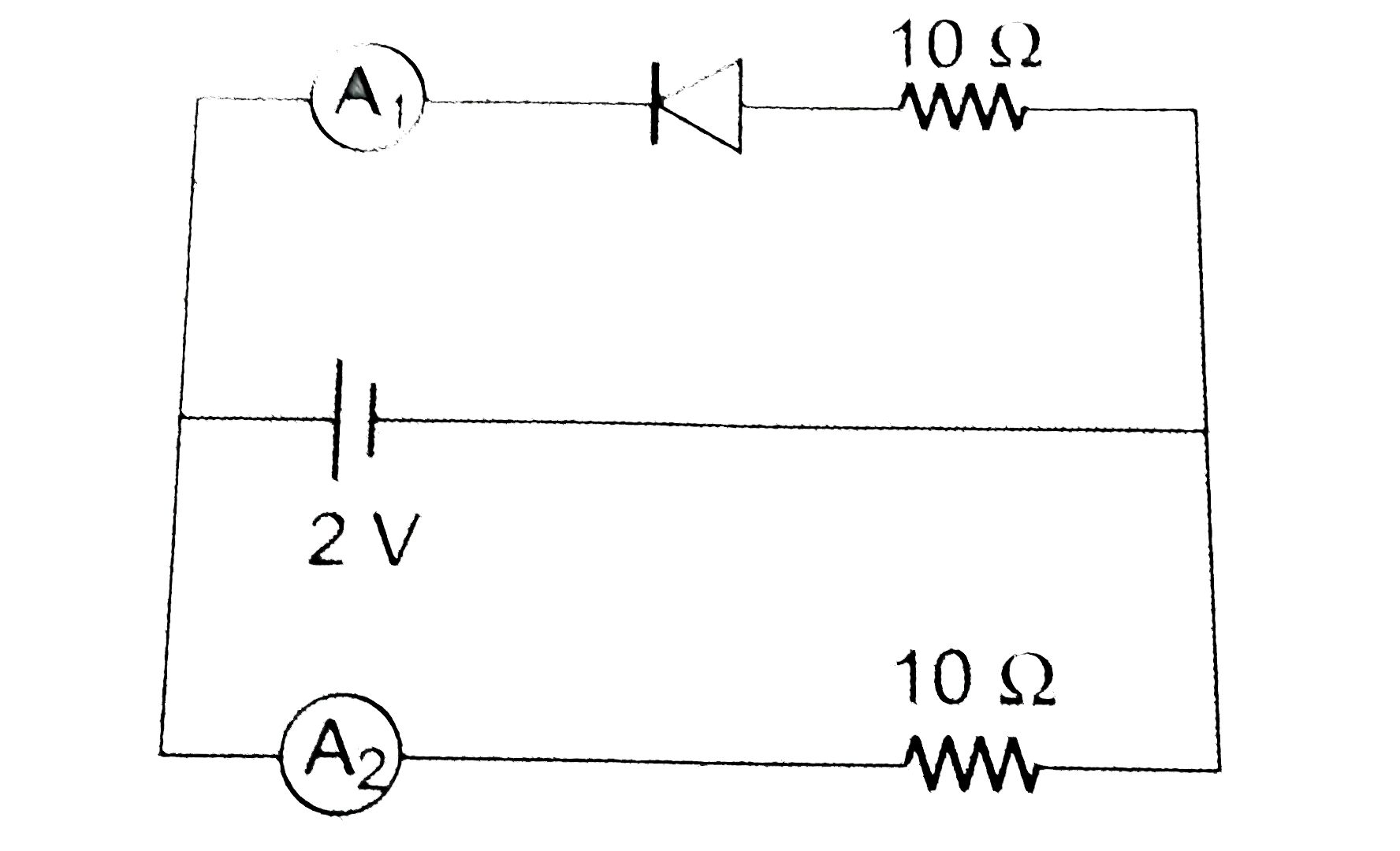

 06:25View Solution
06:25View Solution(i) calculate the value of output voltage `V_(0)` and current `I` if silicon diode and germanium diode conduct at `0.7V` and `0.3 V` respectively. Fig.
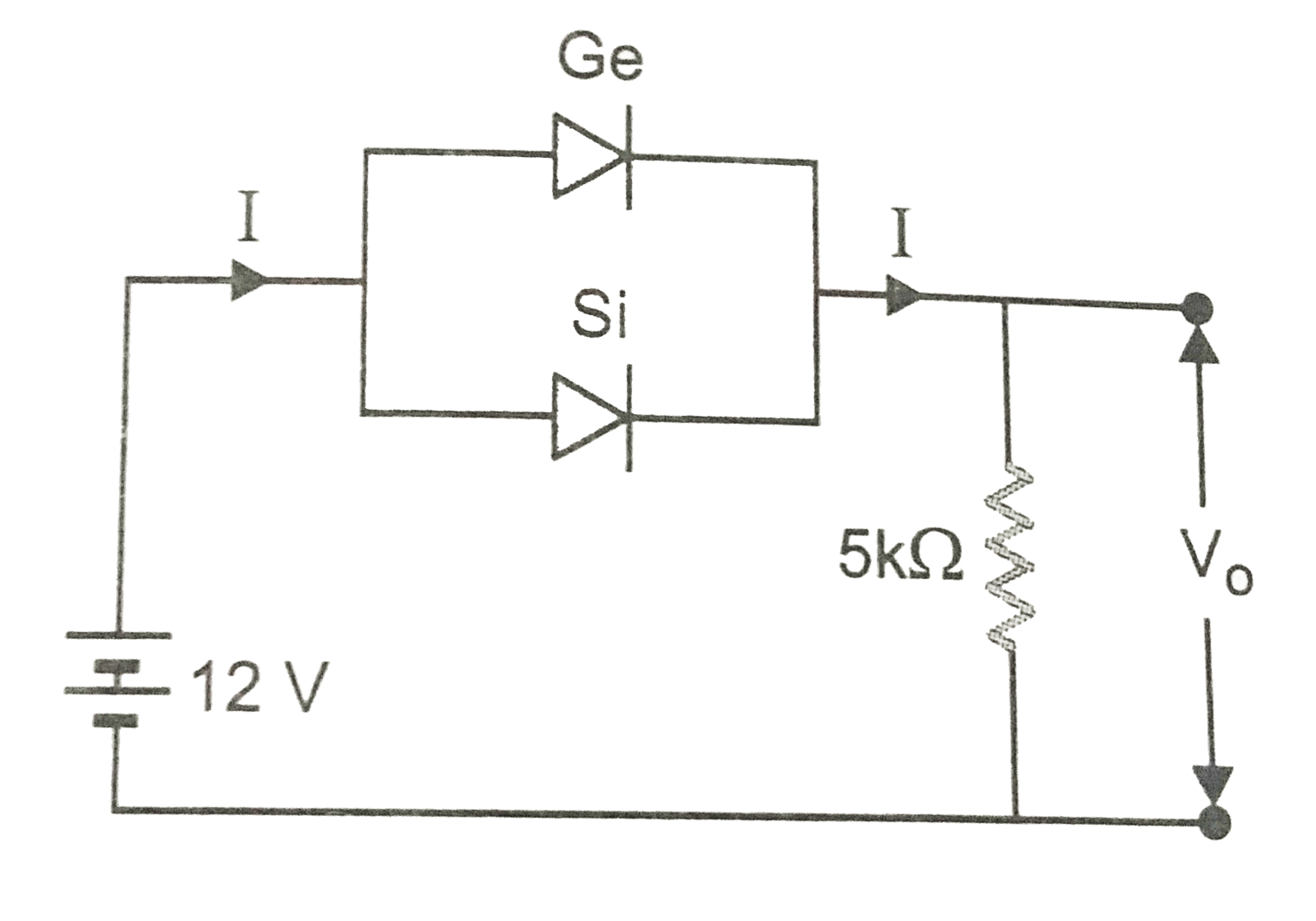
(ii) If now germanium diode is cinnected to `12 V` in reverse polarity, find new values of `V_(0)` and `I`.05:18View SolutionA silicon diode is connected to a load resistance `R_(L)` as shown in the figure. If `V_(in)=15V` and `R_(L)=10kOmega`
(a) If barrier voltage, `V_(B)=0.7V` then calculate
(i) output voltage across `R_(L)`
(ii) current in diode and ltbRgt (iii) forward resistance.
(b) If diode is assumed ideal, then what will be
(i) output voltage and
(ii) output current in diode?
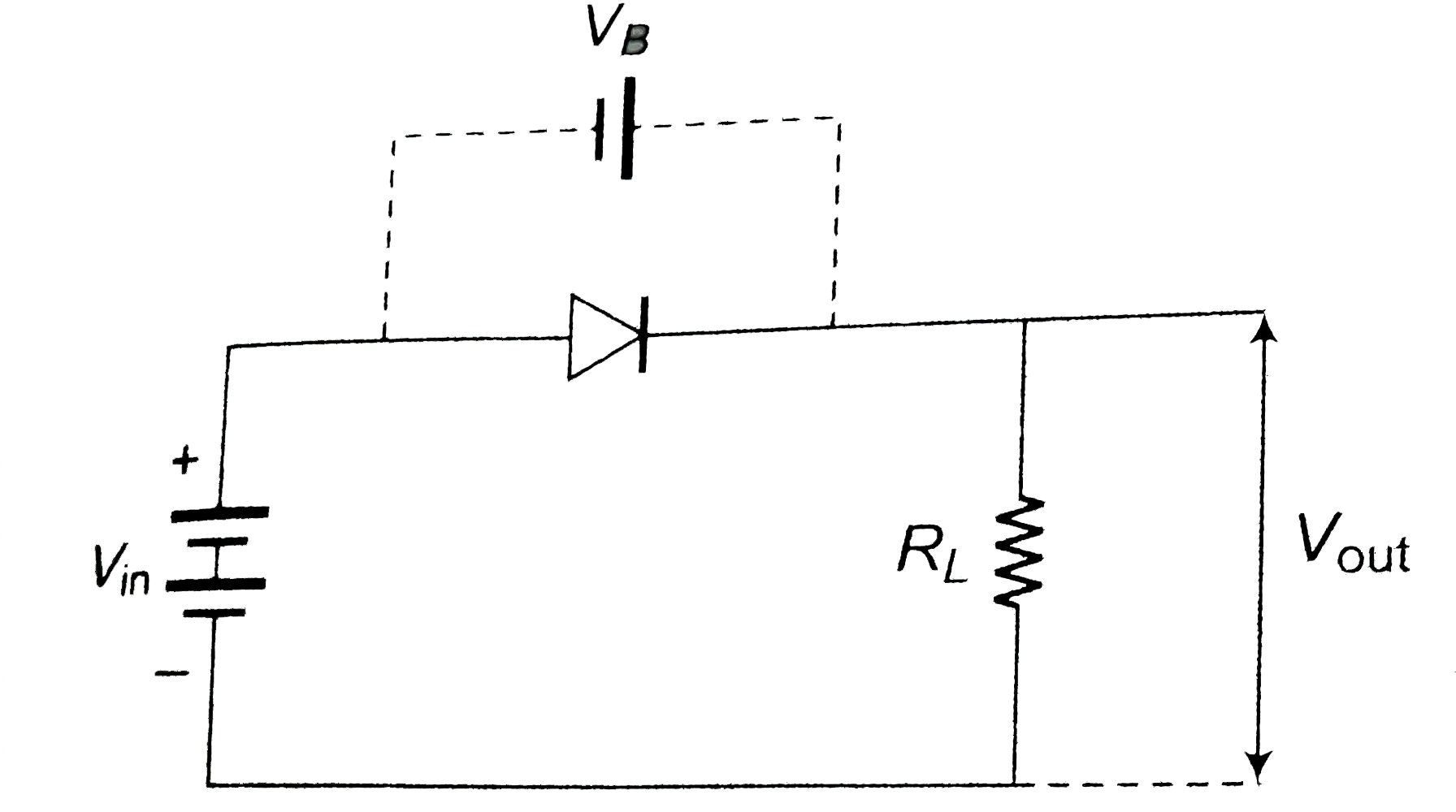 06:01View Solution
06:01View SolutionThe energy of a photon of sodium light `(lambda=589 nm)`equal the band gap of a semiconducting material.(a)Find the minimum energy E requried to create a hole-electron pair.(b)Find the value of `E//kT`at a temperature of 300K.
03:14View SolutionA p-type semoconductor has acceptor levels `57meV `above the valence band. Find the maximum wavelength of light which can create a hole.
04:35View SolutionIn a `n-p-n` transistor `10^(10)` electrons enter the emitter in `10^(-6)s`. `2%` of the elecrons are lost in the base. The current transfer ratio and the current amplification factor will be
03:50View SolutionA change of `8.0mA` in the emitter current brings a change of `7.9mA` in the collector current. How much change in the base current is required to have the same change `7.9mA` in the collector current?Find the values of `(alpha)`and `(beta)`.
04:16View SolutionA`p-n-p` transistor is used in common-emitter mode in an amplifier circuuit. A change of `40muA` in the base current brings a change of `2mA` in collector current and `0.04V` in base-emitter volatage. Find the
(a) input resistance `r_(i)` and
(b) the base current amplification factor `(beta)`.
(c ) if a load of `6kOmega` is used, then also find the voltage gain of the amplifier.04:58View SolutionA transistor is used in common-emitter mode in an amplifier circuit. When a signal 20mV is added to the base-emmiter voltage,the base current changes by `20(mu)A `and the collector current changes by 2mA.The load resistance is `5k(Omega)`.Calculate (a)the factor`(beta)`(b)the input resistance `R_(BE),`(c) the transconductance and (d) the voltage gain .
08:56View SolutionA load resistor of `2 k Omega `is connected in the collector branch of an amplifier circuit using a transistor in common-emitter mode.The current gain`beta-50`.The input resistance of the transistor is `0.50 k Omega`. If the input current is changed by `50 mu A `,(a)by what amount soes the output voltage change by ,(b)by what amount does the input voltage change and (c) what is the power gain ?
06:13View SolutionA transistor is connected in a common emitter configuration.
The collector supply is 8 V and the voltage drop across a resistor of `800 Omega ` in
the collector circuit is 0.5 V. If the current gain factor `(alpha) ` is 0.96 , Find the base
current.02:43View SolutionAn `n-p-n` transistor is connected in common emiter configuration in which collector supply is `8V` and the boltage drop across the load resestance of `800Omega` connected in the collector circuit is `0.8V`. If current gain factor is `(25//26)`, determine the collector -emitter voltage and base current. if the internal resistance of the transistor is `200Omega`. calculate the voltage gain and power gain.
08:04View SolutionAn n-p-n transistor in a common - emitter mode is used as a simple voltage amplifier with a collector current of 4 mA. The positive terminal of a 8 V battery is connected to the collector through a load resistance ` R_L ` and to the base through a resistance ` R_B ` . The collector - emitter voltage ` V_(CE) = 4 V` , the base - emitter voltage ` V_(BE) = 0.6 V` and the current amplification factor ` beta = 100 ` . Calculate the values of ` R_L ` and `R_B` .
05:18View SolutionWrite down truth tables for
(a) `X=A.barB+barA.B`
(b) `X=(A+B)+bar(A.B)`View SolutionLet `X=A bar(BC)+B bar(CA)+C bar(AB)`.Evalute X for
(a)`A=1,B=0,C=1`
(b)`A=B=C=1`
`A=B=C=0`06:55View SolutionConstruct truth table for the function `X` of `A` and `B` as shown in the figure.
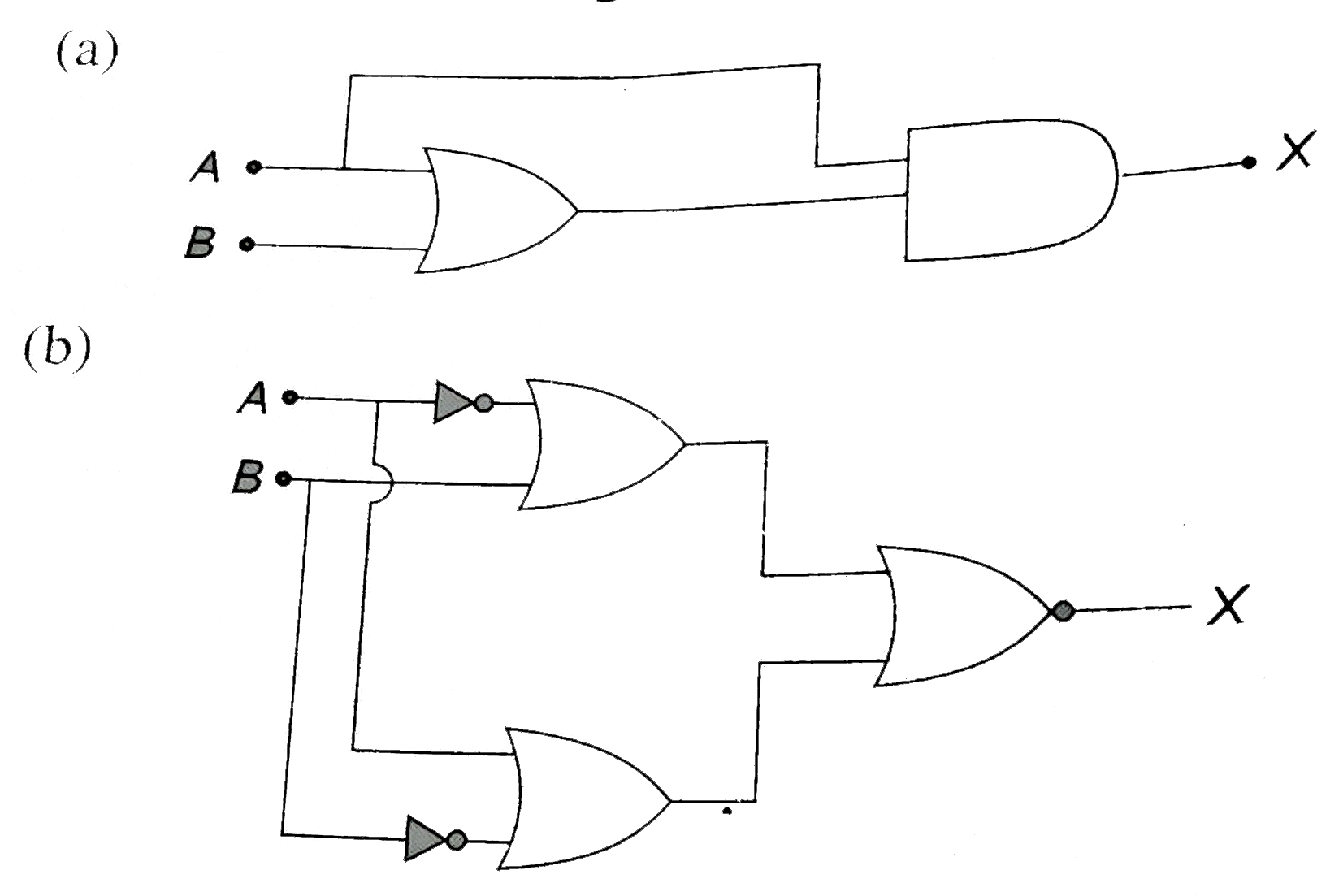 07:32View Solution
07:32View Solution
Example questions and complete solutions for chapter SEMICONDUCTORS of CP SINGH PHYSICS (HINGLISH) of Class 12
